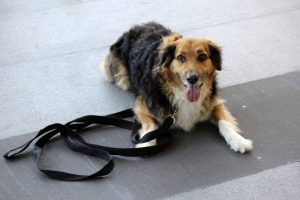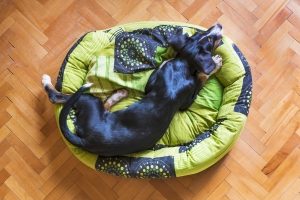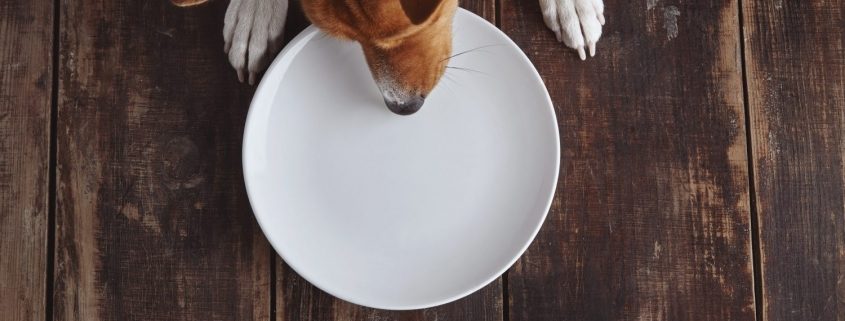Ask Crystal: Counter Surfing Is Not a Sport
Welcome to “Ask Crystal,” where you can ask your pet behavior questions! You can submit your question for Crystal at the bottom of the page!

Dear Crystal,
We got a new puppy. She is now 9 months old and her legs are long enough so she can reach my counters with no problem. So, we can’t leave any food on the counter. She already got a slice of bacon and fried onions, which are deadly to a furbaby, so I called my vet immediately and they told me to induce vomiting, which we did. Luckily, she made it but I need help.
Sincerely,
Worried Mom
Dear Worried,
Unfortunately, counter surfing is a very normal dog behavior. Dogs are opportunistic eaters so they take any opportunity they can get to obtain food. Dogs also do what is rewarding to them. If there is food and they obtain it, that is rewarding which means they are more likely to do it again.
Prevention of practicing the behavior and teaching her incompatible behavior is the key to changing this behavior. The more opportunities the dog has to perform the behavior, the more often they will do it. We start by creating a plan to prevent the dog from having access to food on the counters, tables, etc. Then we decide what we want the dog to do instead of counter surfing and teach them that skill.
Make a plan for preventing the dog from counter surfing at those times when you are preparing food or eating. Depending on the set up of your house, you may be able to use baby gates or free-standing gates from preventing access to food areas for now or permanently. If your dog is crate trained, you can crate them during those times. A tether can be used for short periods to keep your dog in a particular area. Small dogs or puppies can be confined to an exercise pen. Keep your counters and tables wiped clean at all times. Even a small crumb can entice the dog to jump up.
Dogs often counter surf when the owner is not present. It doesn’t make any sense to punish the dog after the fact. Dogs have an association period of 1-2 seconds so they need to be corrected as they are doing the behavior for them to make the connection. Punishment is not an effective training tool for many reasons. First, it may stop the dog from doing the behavior in your presence but the contingency in that method is that you must be present. It doesn’t stop the behavior from happening when you aren’t around. Secondly, you may damage the relationship you have with your dog by scaring it.
 A drag line is a helpful tool for many situations. This is basically a light leash that you attach to the dog to drag around the house. You can either step on the leash to prevent the dog from jumping up or grab the end to stop them and guide them out of the area. It is a lot safer and less stressful than grabbing a dog’s collar which can scare a lot of dogs.
A drag line is a helpful tool for many situations. This is basically a light leash that you attach to the dog to drag around the house. You can either step on the leash to prevent the dog from jumping up or grab the end to stop them and guide them out of the area. It is a lot safer and less stressful than grabbing a dog’s collar which can scare a lot of dogs.
There are usually signs that the dog is about to jump up on the counter if you watch them closely. They may stand very still and/or start air scenting prior to jumping up. If you notice the dog doing these behaviors, you can use an interrupting behavior such as “off” or “leave it” providing that you have taught those behaviors already in a less distracting context. We should avoid saying “no” as that is not a specific enough instruction so it’s not particularly helpful. Always think about what you want the dog to do rather than what you don’t want the dog to do. It’s much easier to teach a dog to do something than to teach them not to do something.
There are many ways to teach a leave it cue. One method is to have a low value treat like a biscuit in one hand and a higher value treat in the other hand. Present the low value treat to the dog in a fist and put the other hand behind your back. Let the dog sniff your hand. The second her nose comes off of your hand say “yes” and feed her the treat from the other hand. Eventually, she will stop nosing your hand and then you can move the criteria to offered eye contact as your rewardable behavior. Then hold the treat out in your flat hand. If the dog moves to the treat, say “leave it” and close your hand and then “yes” when she leaves the hand alone. If she doesn’t go for the food in the open hand and offers eye contact, you can say “yes” and treat that as well. Only say “leave it” when she moves toward the food.
To teach her an incompatible behavior, give her a more rewarding behavior and set it up so that she has to make a choice. Put a leash on her and walk her up to a clean counter. Ask her to sit. Step on the end of leash so that she is physically unable to jump up. When she sits at your side, feed her several high value treats like chicken. Once she is getting the concept, place some low value food on the counter and repeat the first step. Once the dog gets that step, raise the criteria by sticking a high value item like processed cheese on the edge of the counter. The cheese is really sticky and hard to grab. Never let her get the food, always use the leash to prevent that if it looks like she is going to jump up. When she chooses to sit and ignore the food, give her several high value rewards in a row.
The next step is to go back to nothing on the counter but this time instead of stepping on the leash just hold it in your hand. Reward an offered sit rather than asking her to sit and prevent any jumping up attempts by asking her to leave it. Raise the criteria again by placing low value food on the counter and slowly increasing the value of the food as she is successful. Reward her for sitting and ignoring the food with high value treats. Always use a higher value treat than the food on the counter so she is rewarded with something better for leaving the food alone. Practice at various times during the day and on various surfaces like tables in addition to counters and various counters around the house. With enough practice of this training technique, your dog will have been rewarded more often for ignoring food on the counter than for counter surfing.
 You may also consider teaching her a place cue or go to your mat for those times when you want to control her location while you prepare food or eat. I would suggest this in addition to the above training as it is not a substitute for that training but is great for keep a dog from getting in your space while you are eating or cooking. These cues mean that the dog must sit or lie in a particular location until it is released. It’s a handy cue for other situations as well.
You may also consider teaching her a place cue or go to your mat for those times when you want to control her location while you prepare food or eat. I would suggest this in addition to the above training as it is not a substitute for that training but is great for keep a dog from getting in your space while you are eating or cooking. These cues mean that the dog must sit or lie in a particular location until it is released. It’s a handy cue for other situations as well.
I hope these training tips help to keep your puppy safe from eating unsafe foods in the future and give you some peace of mind. It is a little bit of work now that will be so worth it for the life of the dog. Good luck and happy training!
Until next time,
Crystal







